Red curry is the first curry I recommend people make if they are new to Thai cooking. The process is quick, and it is so simple it is essentially fail-proof, but the flavours are so complex and very representative of the spirit of Thai cuisine. It's always a crowd pleaser! Using store bought curry paste is totally find and makes this a quick weeknight meal, but if you love to DIY, I also have a homemade red curry paste recipe for you!
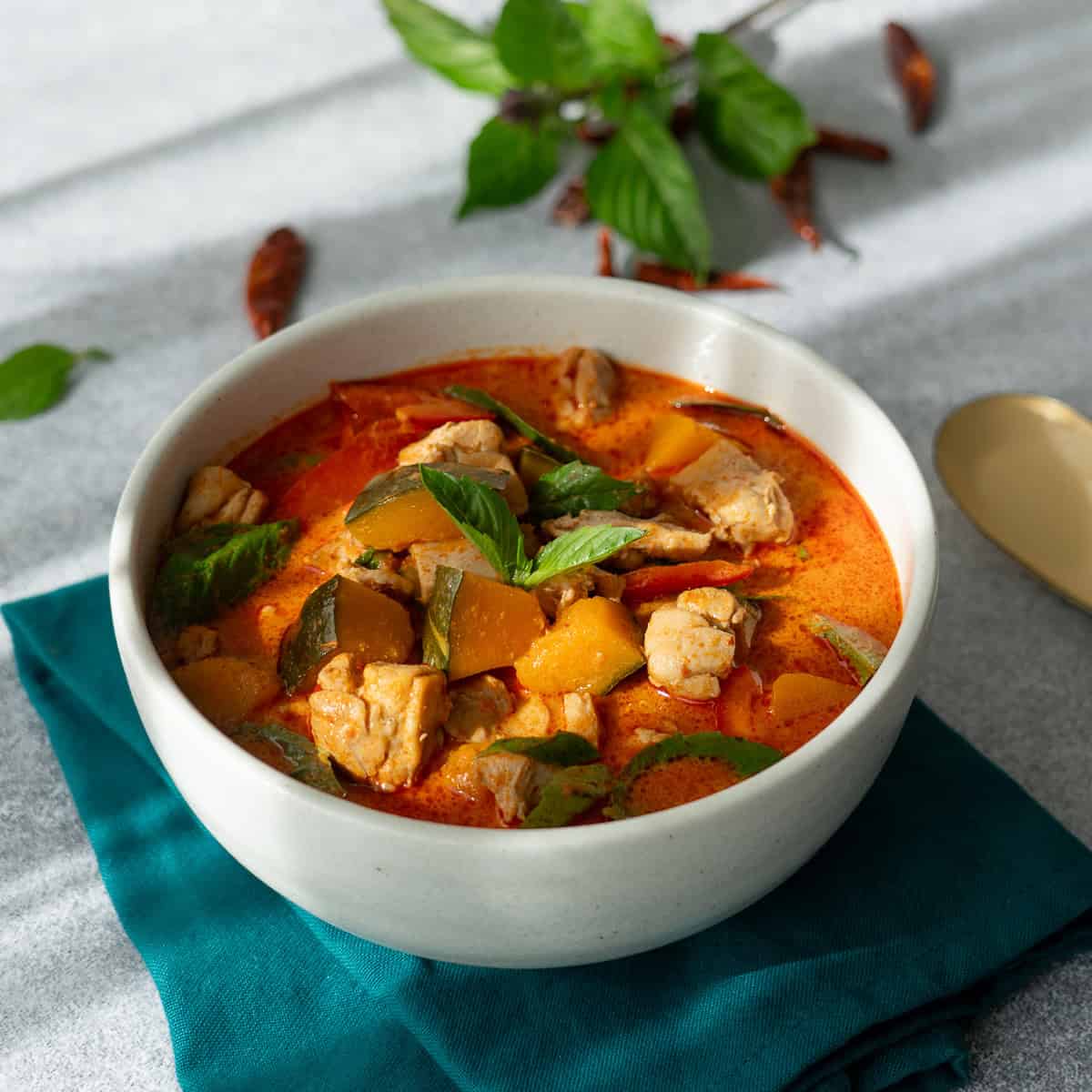
Want to save this recipe?
Jump to:
Ingredients and Notes
Here are ingredients you'll need and important notes about them. For amounts, see the full recipe card below.
- Red curry paste - Using store bought red curry paste is fine, most Thai people do! BUT it's important to choose a good brand as that can make or break your curry. I recommend Maeploy, Aroy-D, or Namjai in that order, and you can see my full review of red curry paste here. If you're feeling ambitious, you can absolutely make your own! Here's my homemade Thai red curry paste recipe.
- Coconut milk - This is what makes the curry rich and creamy, and it's important to use good quality, full-fat coconut milk. See this post on how to choose the best coconut milk.
- Chicken thigh - I highly recommend using chicken thighs over breast so that it can have time to braise in the liquid so it will become tender and load the curry sauce with more chicken flavour.
- Chicken stock - you can theoretically use water, but for maximum flavour, go with chicken stock. You can use store bought or homemade stock, but make sure it's unsalted or at the very least low-sodium because the curry paste and fish sauce are both quite salty already.
- Fish sauce - fish sauce is the key seasoning for all Thai curries! If you're allergic to fish, soy sauce can be used instead. It's important to choose good quality fish sauce, and you can read more about how to choose good fish sauce here.
- Palm sugar - it is traditional to use palm sugar, but light brown sugar or granulated sugar are fine substitutes in this case because the curry is strongly flavoured, so it won't much much difference.
- Kabocha squash - I love using kabocha squash for red curry as the creamy sweetness pairs so well with the curry. However, feel free to substitute other vegetables - Thai eggplant and bamboo shoots are common vegetables for Thai curries.
- Thai basil - If you don't have it, regular Italian basil will do.
- Red pepper - this is added just for some colour. Red bell pepper will do, or anything mild.
How to Make Thai Red Curry Chicken
Here's a bird's eye view of the process. For full instructions, see the recipe card below, and I also recommend watching the video tutorial to ensure success!

- Wash the kabocha squash and slice off any woody blemishes off the skin, but otherwise the skin can be left on. Remove the seeds and cut into bite-sized cubes. (If you have leftover squash, try using it in this stir-fry recipe.)
- Bring ½ cup of coconut milk to a boil, add curry paste and stir to break up lumps.
- Continue cooking and reducing over medium high heat until it is very thick and the coconut oil starts separating from the curry paste.
- Add the chicken and toss to mix with the paste and add the remaining coconut milk.

- Add the chicken stock, half of the fish sauce, and the palm sugar, then simmer for about 8 minutes.
- Add the squash, then simmer on low heat for another 6-8 minutes or until the squash is cooked through.
- Taste the sauce and add more fish sauce as needed. Be sure the make it strong-tasting as it'll be served over plain rice.
- Turn off the heat and stir in Thai basil and red peppers, if using. Enjoy!
Substituting Other Proteins
Anything and everything, but make sure you change the cooking time to match your protein of choice! Everything works with red curry - pork, beef, seafood, you name it.
You can check out my pineapple red curry recipe and a vegan red curry with tofu here as examples. While other curries in Thailand have common meat pairings, for example massaman is usually paired with chicken or beef, the basic a Thai red curry can take any and all proteins.
This is because the flavours of red curry is "basic" relative to other curries, meaning it doesn't have a lot of spices (compared to Thai massaman curry, for example), so the flavours can go with anything from delicate fish to gamey beef.
Substituting Other Vegetables
I like using kabocha squash because creamy squash and red curry is one of my absolute favourite flavour pairings.
While you can use a different kind of squash or whatever vegetables are available to you, here are a few common pairings in Thailand: Thai eggplant, pineapple, winter melon, and bamboo shoots (see the green curry recipe for how to deal with bamboo shoots).
IMPORTANT: Before you change the protein and veggies...
If you're going to use different proteins or vegetables, make sure you adjust the cooking time accordingly. Some cuts of beef takes hours to braise, but shrimp and chicken breast only want to be cooked for 1-2 minutes. The instructions in this recipe only works with chicken thigh!
Some vegetables take a long time to cook, others take 30 seconds. You will have to use your judgement here, or check out my other curry recipes to see how different ingredients are handled!
Is it better to make the curry paste from scratch?

Homemade red curry paste can taste better, but not necessarily. I want to get this misconception out of the way because it hinders many people from making Thai food. You do not have to make the curry paste in order to make "legit" curry, and most Thai people do not make their own curry paste.
Growing up in Thailand my family always bought curry pastes, with the exception of very simple curries such as the sour curry or gaeng som. Go to any markets in Thailand and you'll see mounds of curry pastes people but in bulk.
Making curry paste from scratch is not something I'd do on a weeknight. Even if you're using a power tool to help as shown in my red curry paste recipe, gathering ingredients is no small feat. And just because you made the curry paste from scratch, does not mean you'll end up with a better curry! There are some very good curry pastes on the market that can rival homemade ones.
So when I make curry paste, I do it more for the experience of it. It connects me to the dish and the cuisine in a deeper way, it's a labour of love, and I love it when I can really taste the difference between mine and the store bought one. Or sometimes I make it because it's not available to buy, such as the paste for kao soi.
Which Brand of Curry Paste is the Best?
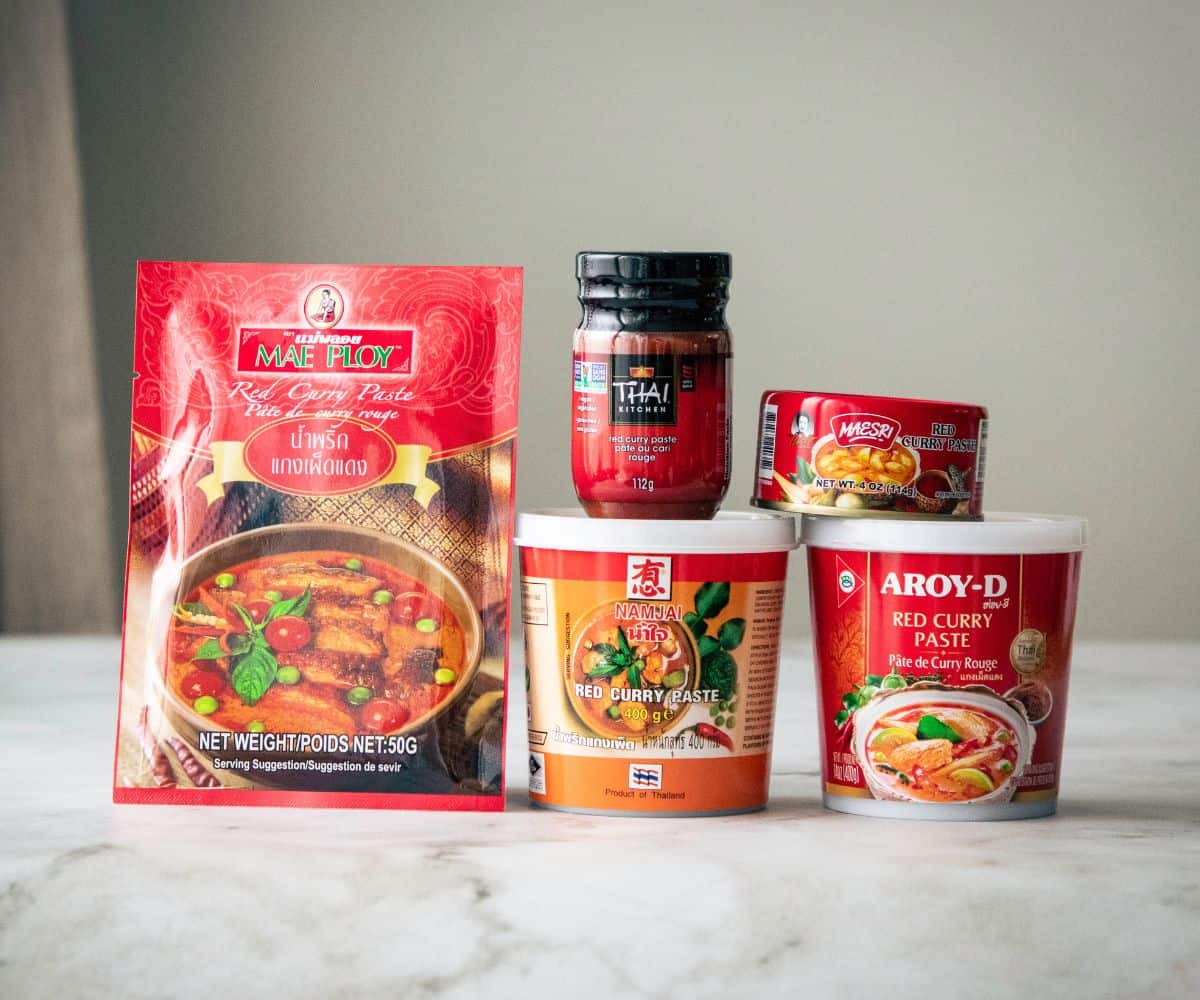
While I haven't tried all of the brands out there, these are the few Thai brands that I have tried and like: Maeploy (my go-to, but it's heavy on the salt), Aroy-D (vegan), and Namjai. See my full review of red curry paste here. Blue Elephant, available in the UK, is also pretty good.
I do not recommend Thai Kitchen as it is very weak. I would use it only if you're cooking for kids or people who cannot handle spice at all (cuz it is not spicy at all), and I would use double the amount the recipe calls for.
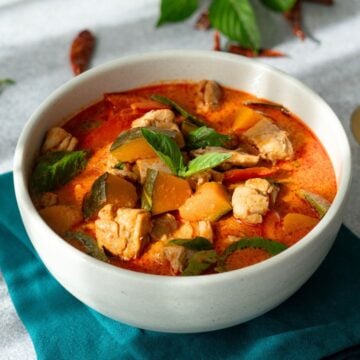
Authentic Thai Red Curry with Chicken
Ingredients
- 2 cups kabocha squash, bite-sized pieces (see note 1)
- 1 ½ cup coconut milk
- 3½-5 tablespoon red curry paste, store bougth, or recipe below (see note 2)
- 1 lb chicken thigh, boneless, skinless, 1.5-inch cubes
- 1 cup chicken stock, unsalted or low sodium
- 2 tablespoon fish sauce
- 2-3 tablespoon palm sugar, finely chopped
- 1 cup Thai basil leaves
- ¼ red bell pepper, julienned (optional for colour)
Red Curry Paste
- 0.4 oz mild dried chilies, such as guajillo or puya, see note 3
- 0.2 oz spicy dried chilies, such as arbol, see note 3
- 1 teaspoon coarse sea salt
- ¼ teaspoon white peppercorns
- ¼ cup chopped shallots
- 3 tablespoon chopped garlic
- 3 tablespoon finely chopped lemongrass, from the bottom half
- 1 tablespoon finely chopped galangal
- 2 chopped cilantro roots, or sub 6 cilantro stems
- 1 teaspoon chopped makrut lime zest, see note 4
- 1 teaspoon fermented shrimp paste (gapi)
Want to save this recipe?
Notes
- To prep kabocha, halve the squash, scoop out the seeds, then cut the half into 1-inch thick wedges. Then cut each wedge down into ½ inch thick pieces. No need to peel the skin, but if there are woody blemishes you can shave those off.
- You can use more or less curry paste depending on your spice tolerance. If using a new curry paste brand, start with 4 tablespoons, unless you like things very spicy then you can add more.
- Mild dried chilies are added for colour and flavour, while the spicy ones are added to customize the paste's heat level. If you can only find the small ones, make sure you remove all the seeds and white pith to remove some heat.
- If you don't have kaffir lime zest, you can add 2-3 kaffir lime leaves to the curry, torn into chunks, about 3 minutes before the curry is done. Or substitute regular lime zest int he curry paste.
FULL VIDEO TUTORIAL
All my recipes come with step-by-step video tutorials with extra tips not mentioned in the blog post, so make sure you watch the video to ensure success. If you enjoy them, consider subscribing to the YouTube Channel to not miss an episode. Thank you!
Subscribe to my YouTube ChannelInstructions
- Wash the kabocha squash and slice off any part of the skin that has blemishes, otherwise the skin can be left on. Remove the seeds by scraping off with a spoon and cut into bite-sized cubes. If you have leftover squash, try using it in this stir-fry recipe!2 cups kabocha squash
- Bring ½ cup of coconut milk to a boil, add curry paste and stir to break up lumps. Continue cooking and reducing over medium high heat until it is very thick and the coconut oil starts separating from the curry paste (if the paste is very thick but no oil is separating, don't worry, just proceed with the recipe).1 ½ cup coconut milk, 3½-5 tablespoon red curry paste
- Add the chicken and toss to mix with the paste. Add the remaining coconut milk and the chicken stock. Season with 1 tablespoon (15 ml) of the fish sauce and the palm sugar, then simmer for about 8 minutes.1 lb chicken thigh, 1 cup chicken stock, 2 tablespoon fish sauce, 2-3 tablespoon palm sugar
- Add the kabocha squash and simmer for about 6-8 minutes, or until the squash is fully cooked and can easily be pierced through with a fork. Be careful not to overcook the squash or it’ll turn to mush.2 cups kabocha squash
- Remove from heat and adjust seasoning with the remaining fish sauce as needed; different brands of curry pastes have different amounts of salt, so it is important to taste and adjust. Stir in Thai basil and red pepper, if using. Serve immediately with jasmine rice.1 cup Thai basil leaves, ¼ red bell pepper
Red Curry Paste
- Cut chilies into chunks, remove the seeds, then grind in a coffee grinder until fine.0.4 oz mild dried chilies, 0.2 oz spicy dried chilies
- In a heavy-duty mortar and pestle, add lemongrass, galangal, cilantro roots, kaffir lime zest, white peppercorns and salt. Pound until fine.1 teaspoon coarse sea salt, ¼ teaspoon white peppercorns, 3 tablespoon finely chopped lemongrass, 1 tablespoon finely chopped galangal, 1 teaspoon chopped makrut lime zest, 2 chopped cilantro roots
- Add ground chilies and pound to mix.
- Add garlic and shallots, pound until fine.3 tablespoon chopped garlic, ¼ cup chopped shallots
- Add shrimp paste, pound to mix.1 teaspoon fermented shrimp paste (gapi)


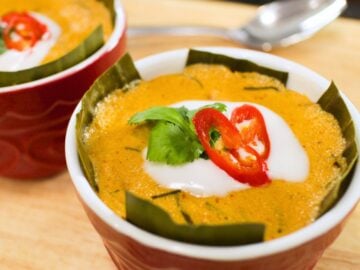
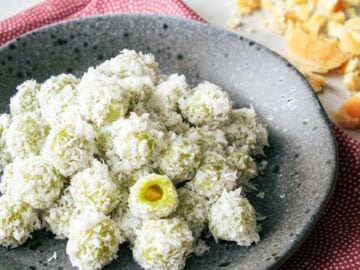
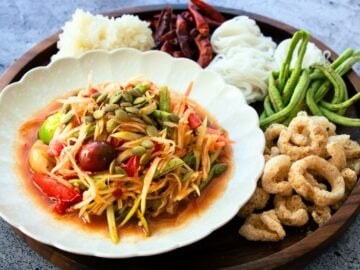
Amanda H says
The recipe is great. Just a bit too much sugar so I had halved it and it allowed everything to stand out so much more
MagicMike says
I’ve used a handful of your recipes and have had so much success with them. I used to be intimidated about making Thai food at home but now I look forward to it. Green and red curry, pad kra pao are my go to’s. They come out better than my local Thai joints. Thanks so much.
Charlie says
I followed your recipe as written. The results were nothing short of amazing! My family absolutely loved it and there were no leftovers! Everyone can't wait until I make it again, so I'll need to double the recipe next time. Just wanted to say thanks.
Allan says
Pailin, thanks again for an incredible recipe!
I just wanted to leave a comment about how I used fresh chillies as well as dried - maybe someone else finds it helpful.
So, I had so many fresh red chillies I decided to press ahead and make this curry even though I didn't find much info online about using fresh instead of dried.
I added 50g fresh milder chillies (without seeds) and 20g fresh red thai chillies — 50% with seeds out. At the last minute though I saw a comment on this page where you had said to another user that it would be possible to use fresh chillies but the taste would be different. So I had mini panic and managed to get 4-5g of dried red dundicut (less spicy than thai chillies) and I added them without seeds to the mix. Crazy, right? 🙂
Anyway - the overall curry was so damn delicious and a perfect super spiciness level that I like! It was fun to experiment but I have ordered some dried chillies online and will try the recipe again soon just using them.
Pailin Chongchitnant says
Glad it worked out and thanks for sharing! They taste different, but definitely both are good! We use fresh chilies in some Thai curries in Thailand, just not this one.
Carol Puri says
Could I substitute sweet potato for squash
Pailin Chongchitnant says
Absolutely, but cooking time may be slightly different.
Alex says
My thai style curries have gotten so much better since watching your videos and using your recipes. Thank you!
The process in this works great. I went off script and used chicken breast, peppers, and onions becuase that's what I had to use up but with the process described it came out great.
Sheree says
I made this, followed instructions closely and even trimmed excess fat from the chicken thighs, but mine was much more oily than what I've gotten in restaurants? Could it be because I made a double recipe?
Pailin Chongchitnant says
So there SHOULD be some amount of oil on the top of the curry, that's how Thai curries are because the coconut milk has separated from when you reduce it in the beginning, plus the fat from the chicken. In restaurants they often skip this step because some customers don't like to see oil on the surface. If you don't like the oiliness, simply skim it off the surface at the end 🙂